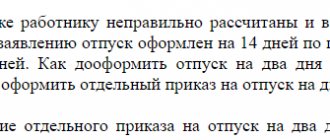Calculation of average earnings
What formula is used to calculate SZ depends on whether the employee has fully worked the pay period. This is the 12 calendar months preceding the vacation.
Here is the formula for the case when the employee worked the entire pay period:
Average daily earnings = Earnings for the billing period / 12 / 29.3
Note: 29.3 is a constant indicator. This is the average monthly number of calendar days.
If the employee did not work fully during the billing period or there were deductible days (for example, sick leave, vacation, etc.), the formula is more complex:
Average daily earnings = Payments that are included in the calculation of SZ / (Average monthly number of calendar days × Number of fully worked months + Number of calendar days worked in partial months)
The last indicator, in turn, is considered as follows:
Number of calendar days worked in an incomplete month = Average monthly number of calendar days / Total number of calendar days in a given month × Number of calendar days in a given month attributable to hours worked
Example 1. The employee worked the entire billing period
The employee took leave for 28 calendar days. Earnings for the 12 months preceding the vacation amounted to 800,000 rubles.
Total average daily earnings are: 800,000 rubles / 12 months / 29.3 = 2275.31 rubles
Amount to be paid: 2275.31 * 28 = 63,708.68 rubles
Pay vacation pay at least 3 calendar days before the start of your vacation. For example, is Monday the first day of vacation? This means that on Thursday the day before, vacation pay should already fall into the employee’s wallet or card
Example 2. The billing period has not been fully worked out
An employee's vacation is 14 calendar days from July 10 to July 23. Salary - 20,000 rubles.
The billing period is from July 1, 2021 to June 30, 2021.
In February, the employee took sick leave for 10 days (from February 3 to 12) and received a salary for this month of 11,578.95 rubles.
1. Let’s determine the payments that are included in the calculation of average earnings
Total amount of payments, excluding February: 20,000 rubles * 11 months = 220,000 rubles
Payments from February: 220,000 rubles + 11,578.95 rubles = 231,578.95 rubles
2. Let’s calculate the number of days worked in February
There are a total of 28 calendar days in February in 2021. 10 of them the employee was sick. This means that the days worked accounted for 18 calendar days (28-10).
For calculation purposes, 18,836 days were worked in February (29.3/28*18).
3. Find the average daily earnings
231,578.95 / (29.3 * 11 months + 18,836 days) = 678.85 rubles.
4. Calculate the amount of vacation pay
678.85 * 14 = 9,503.9 rubles.
Are vacation pay included in the calculation of average earnings?
In 2007, a decree was issued that prescribed new rules for calculating the average salary of an employee. The calculations include absolutely all payments to the employee from the employer, which are taken into account in determining the tax base for the Unified Social Tax, transferred to the Social Insurance Fund of the Russian Federation.
In this regard, one point has always been unclear for accounting employees: what to do with vacation pay that was paid to an employee in the current year, because they are also subject to accounting for the unified social tax.
Resolution of the Government of the Russian Federation No. 375 provided an explanation for this not entirely clear point: vacation pay is not included in the calculation of average earnings.
When calculating an employee's average earnings, the following should not be taken into account:
- Time spent on vacation Time spent on a business trip Time of incapacity for work Time of leave related to pregnancy, childbirth, child care
Expert opinion
Mikhailov Vladislav Ivanovich
Lawyer with 6 years of experience. Specializes in family law. Knows everything about the law.
Also, social benefits that cannot be classified as wages are not taken into account when calculating the average employee’s earnings. Such payments include cash assistance, employer payment for food and travel, compensation for fuel and lubricants, and so on.
How to calculate average earnings
The average monthly salary includes bonuses and incentives that are included in the employee’s salary. Quarterly and annual premiums must be included in the billing period.
Bonus in calculation of holiday pay
The employee received a bonus during the pay period. Should I take it into account when calculating vacation pay?
Yes, if this is a bonus for those months that fell within the billing period (Letter of the Ministry of Health and Social Development dated 03/05/08 No. 535-17).
Example 3. Accounting for bonuses when calculating vacation pay
The employee goes on annual paid leave for 28 calendar days. Earnings for the 12 months preceding the vacation amounted to 1,000,000 rubles. In addition, the employee received a monthly bonus of 5,000 rubles every month.
The employee’s income from the monthly bonus for the year amounted to 60,000 rubles. (5,000 rubles * 12 months).
Average daily earnings are: (1,000,000 rubles + 60,000 rubles) / 12 months / 29.3 = 3,014.79 rubles.
Average daily earnings are: (1,000,000 rubles + 60,000 rubles) / 12 months / 29.3 = 3,014.79 rubles.
Income tax
Organizations take into account the costs of paying the main annual leave established by law when calculating income tax and the simplified tax system with the object of taxation “income minus expenses” as labor costs. Since vacation pay is a labor expense, they are taken into account in the period to which they relate (Clause 7, Article 255 of the Tax Code of the Russian Federation). According to regulatory authorities, vacation pay should be taken into account in income tax expenses in the period to which they relate, regardless of when they were paid.
Special calculation of vacation pay in working days
Before this, we counted vacation pay in calendar days. Employers accrue vacation in working days in two cases:
- seasonal workers,
- if a person works under an employment contract that is valid for up to two months.
Formulas:
Amount of vacation pay in working days = Average daily earnings × Number of working days of vacation
Average daily earnings = Actual accrued wages / Number of working days according to the calendar of a 6-day working week
In fact, accrued wages are payment for the work that the employee received from the first day of work until the start of vacation.
Example 4. Calculation of vacation pay for a seasonal worker
The employee goes on vacation for 12 working days. The actual accrued wages amounted to 600,000 rubles. The number of working days according to the calendar of a 6-day working week for six months is 111 days.
Average daily earnings: 600,000 rubles / 111 days = 5,405.41 rubles
Vacation pay: 5,405.41 rubles * 12 days = 64,864.92 rubles.
General procedure for calculating vacation pay
The first important step is to accurately determine the period that will be considered calculated. Labor legislation defines it as standard - before taking leave it is at least 12 months according to the calendar.
Next, calculate the amount of payments accrued during this time. Accounting is carried out for any concepts, according to the current system introduced by employers.
It doesn't matter where the money comes from.
Additional factors are taken into account along with the main part:
- Regional coefficients.
- Combined positions.
- Night work.
- Overtime work.
- Additional payment for going on site on holidays and weekends.
And so on. The final figure is divided by 12, then by 29.4. The result is the average reward throughout the day. The amount of vacation pay is determined after multiplying the previous number by the days according to the calendar that make up the vacation.
For example, a break from work for an employee will be 14 calendar days. Start – 05.04. For each of the 12 months preceding the vacation, the amount of accrued salary is 30 thousand rubles.
The benefit amount is calculated as follows: multiply 30 thousand by 12, then divide by 12, divide by 29.4, multiply by 14 days. The result is 14 thousand rubles.
The calculation is associated with certain difficulties in case of one or several months with incomplete work. The same applies to situations where a citizen was absent from work for some time.
Difficulties arise when at least one condition is met in the billing period:
- Exemption from work in various situations, with or without pay.
- Lack of work due to downtime caused by the employer. Or when the reasons do not depend on either party.
- Vacation or business trip.
- Caring for disabled people since childhood, disabled children, requiring additional paid days off.
- Strikes without the participation of citizens, preventing them from fulfilling their duties.
- Benefits for temporary disability, pregnancy and childbirth.
Calculations do not include the periods indicated above. The same applies to payments accrued for such time.
Partially worked period
Clause 10 of the Regulations determines the number of days to be used when calculating the average salary:
The average number of days of the month (29.3) is divided by the total number of days of the month.
Multiply the result by the actual days worked in a given month.
The last indicator is calculated: the total amount of calendar days in one month is reduced by the amount of calendar days located in the period not included in the calculation period.
Since April 2, 2014, the average number of days per month is 29.3
The procedure for calculating vacation pay in 2019
If the calendar year has been worked in full, the calculation of the average daily earnings for calculating vacation pay is carried out according to the standard formula. The total amount of wages and income included in it for the previous 12 months is divided by 12 and 29.4. The last figure is calculated annually and is included in the Labor Code of the Russian Federation as an amendment.
This is important to know: self-employed people on maternity leave
Since in practice it is rarely possible to fully work out a calendar year, it is necessary to adjust the annual income taking into account available sick leave, financial assistance and bonuses. Additional payments can significantly increase average daily earnings (ADW), and the availability of sick leave benefits can slightly reduce it - this depends on the duration of the certificate of incapacity for work.
The calculation of SDZ for an incompletely worked working month is calculated as the accrued amount of wages without sick leave , divided by days worked according to the calendar and adjusted by a factor of 29.4.
So, the average earnings, subject to the condition that the year has been worked in full, will be:
20000 x 12: (12 x 29.4) = 682.7 rub.
Taking into account sick leave:
From this example it follows that the time spent and the amount of sick leave are not included in the calculation of vacation pay and do not significantly affect the calculation of SDZ.
If during the 12 months of the accounting year there were some months when the employee was absent for some reason or income that was not subject to inclusion in the payroll was deducted, the SDZ calculation is calculated by dividing the total amount of accrued wages for the previous accounting period by the average monthly value of calendar days (29.4), multiplied by the number of full months and calendar days in partially worked months.
Which payments are included in the calculation base and which are not?
Certain provisions of the labor code clearly indicate which days and payments are used when calculating vacation pay and which are not. In this regard, we will create a small table:
- employee salary;
- percentage of revenue;
- payment in kind;
- monetary allowances for employees of government agencies and municipalities;
- fees from media and cultural organizations;
- allowances and surcharges.
| Payments that are excluded from the base | Amounts to be taken into account |
|
Sometimes employees are paid bonuses that are permanent and secured by internal regulations. These payments are also subject to accounting when calculating vacation benefits.
This is important to know: When they issue a work book after a vacation followed by dismissal





